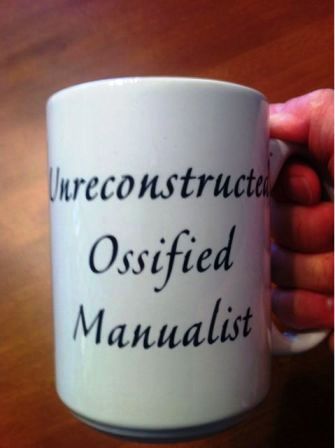QUAERITUR:
My family plans to give a priest a chalice (he is from Ireland and does not have one of his own here in the US) and I have the following
questions: [Usually I take one question at a time, but today I am feeling benevolent.]
1) Must it be consecrated before using it to hold the Precious Blood of Our Lord Jesus Christ?
2) If so, who can do the consecration? Can the priest do it himself or must it be done by a bishop?
3) Can the consecration be done during mass or must it be done before mass?
4) What are the applicable canons that cover this?
1) It should be consecrated before hand, yes. But if it is not, after it’s first use it will be by the very fact of its use at least sanctified, if not consecrated. More on that later.
2) This is more properly a task for a bishop, but a priest can do it too.
3) See 1.
4) This is not mentioned in the Code of Canon Law, but some directions can be found in the rubrics, which is a species of canon law.
I warmly recommend the use of the older form, by a bishop. It is rich and inspiring in a way that the modern form… isn’t. I wrote about that HERE and HERE.
Following the Novus Ordo, however, the chalice, paten, and ciborium are usually blessed at Mass, using the text in the Missal. I do not see a formula in the Missal for blessing the chalice or ciborium outside of Mass.
I hold to the argument that an unconsecrated chalice used for Mass may thereafter be considered sanctified but not consecrated. A chalice that is consecrated and then used for Mass is also sanctified. By consecration a chalice is formally, by special rites, set apart for a particular use.
“But Father! But Father!”, some of you are warbling. “This is just merciless nitpicking. You are nitpicking merciless nitpicker! You hate mercy and compassion and all those…. other things that Pope Francis talks about … like… the Earth’s climate and fairness and … and you hate Vatican II!”
We can grant that the sanctification which the chalice receives in its use at Mass could be the equivalent of consecration, but the special formal act is still lacking. I think we have to make the distinction.
And, frankly, why not consecrate the chalice with the special rite that Holy Church provides? Why not?
Thanks for asking about this. It got me thinking.
I have been thinking that it is time to have my chalice regilded. My 25th Jubilee is coming up. After a quarter century of use, the chalice and paten made at the time of my ordination are worn down to the silver in some places. Perhaps there is a reader out there who would like to help with this project… but I digress.
 Because we are Unreconstructed Ossified Manualists around here, let’s drill into this question of restoration and regilding.
Because we are Unreconstructed Ossified Manualists around here, let’s drill into this question of restoration and regilding.
Thus the question is raised:
QUAERITUR:
Must a chalice be re-consecrated after it has been replated, reguilded, restored?
Auctores scinduntur.
Some (e.g., Suarez) argue for reconsecration after regilding because the new surface is not consecrated. They perceive the new surface as something morally separate from the rest of the chalice. Others (e.g., Lugo) say that once it is consecrated, the whole chalice, new surface included, remains consecrated no matter how many times it is regilded because the new surface is morally part of the whole chalice.
Think of it this way. If you paint a church’s interior, you don’t have to reconsecrate it. As Lugo argues in De Sacramento Eucharistiae (Disp. 20. n. 95):
“Ergo si manet calix, qui consecratus fuit, non opportet consecrare, illam novam superficiem, sicut neque in ecclesia, quae de nova dealbatur, oportet de novo consecrare superficiem novam.“
Most theologians took the negative position.
 However, on 14 June 1845 the Congregation of Rites settled the issue. The question was asked:
However, on 14 June 1845 the Congregation of Rites settled the issue. The question was asked:
“Ut declarare dignaretur, utrum calix et patena suam amittant consecrationem per novam deaurationem, et sic indigeant nova consecratione?”
The reply: “Affirmative; amittere nimirum, et indigere iuxta exposita.”
The more modern Lehmkuhl (Vol. 2, n. 228, 3), however, says:
“Neque pro practice probabili haberi potest aliquorum veterum opinio vasa vel vestimenta sacra si ante consecrationem vel benedictionem, sive bona sive mala fide sacrificio missae servierint, pro iam consecratis haberi posse.“
I refer you now back to my earlier point that their use in Mass sanctifies but doesn’t consecrate them. Consecration is something different, separate.
Then you have the situation of a chalice that needs to be reconstructed in some way, as in the case wherein the cup becomes separated, broken off, from the stem, or stem from the base, etc. I once had repaired a broken 19th century silver chalice with stamps of the Papal States. I took it to my bishop for consecration with the older rite and he was happy to do it.
If the chalice is made so that the cup unscrews from the stem, etc., then separation by unscrewing doesn’t require that the chalice be reconsecrated after reguilding of the parts. However, it they are broken, I would say, yes, the chalice has to be reconsecrated.
I would also say that if things are added to the chalice or it is altered in a major way, it should be reconsecrated. For example, because St. Therese of Lisieux did something for me back in my bad seminary days, and I had a classic “sign of roses” that some people experience, I designed the chalice to have a wreath of roses at the top of the base. However, the roses are actually places for small jewels to be set, but they remain to this day filled in. I thought that, as some point, I would ask my mother to provide some small stones from her jewelry, which would be yet another a great way to keep her in mind during Mass. (Yes, Fishwrapers, Fr. Z has a mother. He wasn’t assembled from spare parts in a lab.) And there are a few other small changes I would make. In that case, I would have the chalice reconsecrated.
Similarly, if we do major work on an altar such that it is radically changed, or if the table becomes separated or broken in any way, then it has to be reconsecrated.
Let’s not be minimalists. These gestures and rites mean something for our Catholic identity.




































In reading your previous posts which you linked to, the following statement got me thinking:
“…by consecrations objects and people are, as it were, removed from the secular, temporal realm and given over instead to God exclusively. It is as if they are extracted from the world under the domination of its diabolical “prince” and given exclusively to the King. Before, they were “profane”. After, they are “sacred”. Thus, a consecration is a once for all time act. Once something is consecrated, it is forever consecrated. Blessings can be repeated. Thus, harming or doing wrong to or with something or someone who is consecrated is thus its own kind of sin: sacrilege.”
Would a consecration that a person does of oneself (such as my performing a total consecration to the Blessed Mother using St. Louis de Montfort’s formula) hold the same dignity as a consecration of an object done by a bishop? [No. “Consecration” in that context is an equivocal use of the word to designate a kind of promise or vow.]
If so, this leads to my follow-up question: If my wife were to call me a dummy, could I accuse her of sacrilege? :) [Okay… I saw what you did there.]
When Holy Communion is given under both kinds, should those “mini” chalices also be consecrated? I have a feeling this does not happen…
Regarding:
“Others (e.g., Lugo) say that once it is consecrated, the whole chalice, new surface included, remains consecrated no matter how many times it is regilded because the new surface is morally part of the whole chalice.”
Does anyone argue that this constitutes “spooky consecration at a distance”, analogous to “spooky action at a distance”?
At first glance I read “fairness” as “fairies”. Well, y’know, I wouldn’t be at all surprised if Francis loved fairies and Fr. Z hated them! (Hey! Listen!)
I enjoy learning these details. I’ve never understood how some people conclude that simply because such rituals are not the core of our faith that they don’t add anything to it and should be done away with.
Also, my Latin was rudimentary at best, and continues to fade. I think I have the general gist of the Latin quotes, from context as much as remembering vocabulary and endings, but I’d enjoy reading a translation from Father or someone else more competent than myself.
I have read somewhere that some priests rap their chalice with their finger as a way to deconsecrate it before repairs. The article also stated that was inappropriate. I have also wondered about those mini-chalices, but then again I will have to assume there is a progressive using a coffee mug as a chalice somewhere. I also wonder why those mini chalices never are rinsed with the water the way the priest’s used to do. It seems the purificator is simply stuffed into the chalice, while the priest often drapes the same cloth over the chalice. Finally what ever happened to the chalice veil?
ChesterFrank, I can’t speak for other places, but I can tell you what happens in my middle-of-the road Ordinary Form parish.
When we got the new “mini” chalices, for lack of a better term, our pastor consecrated them using the prayer in the back of the Missal. I believe this was just after the new translation went into use.
The chalices are all purified with water at the altar by the priest or deacon.
We do use a chalice veil and burse for the main chalice, but not for the other chalices.
iamlucky13:
Here is my translation trying to follow the Latin word order as closely as possible.
“Ergo si manet calix, qui consecratus fuit, non opportet consecrare, illam novam superficiem, sicut neque in ecclesia, quae de nova dealbatur, oportet de novo consecrare superficiem novam.“
Therefore if the chalice remains, the one that was consecrated, a consecration is not needed of the new surface, just as in a church that is newly painted it isn’t needed to consecrate again the new surface.
“Ut declarare dignaretur, utrum calix et patena suam amittant consecrationem per novam deaurationem, et sic indigeant nova consecratione?”
That it would deign to declare wheather a chalice and a patten loose it’s consecration through a new gold plating, and thus be in need of a new consecration.
“Affirmative; amittere nimirum, et indigere iuxta exposita.”
Affirmative; to loose surely, and to need in accordance as put forth.
“Neque pro practice probabili haberi potest aliquorum veterum opinio vasa vel vestimenta sacra si ante consecrationem vel benedictionem, sive bona sive mala fide sacrificio missae servierint, pro iam consecratis haberi posse.“
Nor can the very old opinion of some be held to be practically probable, that sacred vessels and vestments if before consecration or a benediction, either in good faith or not, were used in the sacrifice of the mass, that they can be held as already having been consecrated.
Thanks Andrew!